As parents across the globe, we pour our hearts into ensuring our children are healthy, happy, and thriving. While we often focus on their physical and academic development, the importance of Supporting Your Child’s Emotional Well-being cannot be overstated. A strong emotional foundation equips children with the resilience to navigate life’s challenges, build healthy relationships, and flourish into well-adjusted adults. The good news is that fostering your child’s emotional well-being doesn’t require grand gestures; it’s often the small, consistent daily habits that make the biggest difference. Let’s explore ten powerful practices you can weave into your family’s routine to support your children’s emotional well-being.

1. Start the Day with Connection to Boost Emotional Well-being
How your child begins their day can significantly impact their emotional state. Instead of rushing through the morning routine, try to incorporate a few moments of genuine connection. This could be a warm hug, a few minutes of focused conversation, or simply sitting together during breakfast without distractions.
- Actionable Tip: Before the hustle begins, spend 5-10 minutes engaging with your child. Ask them how they slept, what they’re looking forward to, or simply offer a comforting presence.
2. Practice Active Listening to Supporting Your Child’s Emotional Well-being
Truly hearing your child, not just listening to respond, is fundamental to supporting their emotional well-being. When they share their feelings, put aside distractions, make eye contact, and try to understand their perspective, even if you don’t agree with it.
- Actionable Tip: When your child is talking about something important, use phrases like, “It sounds like you’re feeling…” or “Can you tell me more about that?” to show you’re actively engaged. (Outbound Link: Consider linking to a reputable child psychology resource like the Child Mind Institute for more on active listening: [Search for “Child Mind Institute active listening”] )
3. Encourage Emotional Expression in Healthy Ways
Help your child understand that all emotions are valid, even the uncomfortable ones like sadness, anger, or frustration. Teach them healthy ways to express these feelings, such as talking about them, drawing, writing in a journal, or engaging in physical activity.
- Actionable Tip: Create a “feelings chart” together or have a designated “calm-down corner” with tools like stress balls or coloring books.
4. Model Healthy Emotional Regulation for Your Children
Children learn by observing. Show them how you manage your own emotions in healthy ways. If you’re feeling stressed, verbalize it calmly and demonstrate coping mechanisms like taking deep breaths or going for a short walk.
- Actionable Tip: The next time you’re feeling overwhelmed, say something like, “I’m feeling a bit stressed right now, so I’m going to take a few deep breaths to help me calm down.”

5. Prioritize Playtime for Emotional Release and Growth
Play is not just fun; it’s essential for a child’s emotional well-being. Through play, children explore their world, process emotions, develop social skills, and build confidence. Make unstructured playtime a daily priority.
- Actionable Tip: Dedicate at least 30-60 minutes each day for free play where your child can choose the activity and lead the way.
6. Teach Problem-Solving Skills to Build Emotional Resilience
When your child faces a challenge, resist the urge to immediately solve it for them. Instead, guide them through the problem-solving process. This empowers them and builds their resilience in navigating future difficulties.
- Actionable Tip: Ask questions like, “What are some things you could try?” or “What happened last time you faced a similar problem?”
7. Foster Gratitude and Positive Thinking for a Brighter Outlook
Encouraging gratitude can shift your child’s focus towards the positive aspects of their life, boosting their overall emotional well-being. Make it a daily habit to reflect on things you’re thankful for as a family.
- Actionable Tip: At dinner time, go around the table and have each person share one thing they are grateful for that day.
8. Establish Predictable Routines for Security and Emotional Stability
Children thrive on structure and predictability. Knowing what to expect provides a sense of security and can reduce anxiety, contributing significantly to their emotional well-being.
- Actionable Tip: Maintain consistent daily routines for mealtimes, bedtime, and homework. Visual schedules can be particularly helpful for younger children.

9. Encourage Empathy and Kindness Towards Others
Helping your child understand and share the feelings of others fosters empathy, a crucial component of social and emotional well-being. Encourage acts of kindness, both big and small.
- Actionable Tip: Talk about how other people might be feeling in different situations and discuss ways to show kindness and support. (Outbound Link: Consider linking to a resource on fostering empathy in children, such as Greater Good Magazine: [Search for “Greater Good Magazine empathy children”] )
10. Prioritize Quality Family Time to Strengthen Emotional Bonds
Spending quality time together as a family strengthens bonds, creates positive memories, and reinforces your love and support, all vital for your child’s emotional well-being.
- Actionable Tip: Schedule regular family activities, even if it’s just a weekly game night or a weekend walk in the park. Be present and engaged during this time.
Key Takeaways for Supporting Your Child’s Emotional Well-being
Nurturing your child’s emotional well-being is an ongoing journey, not a destination. By incorporating these ten daily habits, you can create a supportive and loving environment where your child feels safe, understood, and empowered to thrive emotionally. Remember that consistency and patience are key, and celebrating small steps forward can make a big difference in your children’s emotional well-being Positive Parenting Solutions.






























